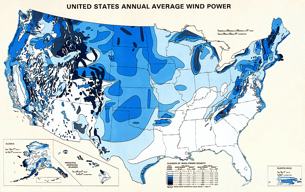Wind Site Analysis
Before investing in any wind energy equipment, it's critical to determine whether your property is suitable for generating power from wind. Even if it seems like it's always windy in your location, there are many areas around the country where wind energy just isn't cost-effective.
Obviously, a residential wind energy system requires wind in order to work; the more, the better. Determining exactly how much wind you'll need depends on several things. First, is the wind energy system going to be grid-connected? If so, it will be used in conjunction with 'traditional' energy from your electricity supplier. In this situation, the amount of wind is less important; when there's not enough of it, energy from the grid will pick up the slack.
If your goal is an off-grid system, wind energy is typically used in a hybrid system with solar panels. Off-grid homes are completely dependent on the wind and sun for all energy needs; this situation requires more constant winds (and higher wind speeds) to be effective.
Determining Wind Speed
Generally speaking, most residential wind turbines require a 7 mph wind to get started (this is called the 'cut-in' speed) and an average of 10-12 mph for at least 6 hours a day in order to generate power.The U.S. Department of Energy wind program is a useful resource in determining whether your location is suitable for wind power or not. The data they compile shows wind speed averages at 150 feet above ground (50 meters) , which is a typical height for a larger 10 kilowatt turbine. These maps can help identify good locations for wind energy.
http://www.windpoweringamerica.gov/windmaps/community_scale.asp
For smaller wind turbines (installed at lower heights), a hand-held anemometer (air velocity meter) is used to measure wind speed. Again, the U.S. Dept. of Energy has a helpful guide to anemometer loan programs:
http://www.windpoweringamerica.gov/anemometerloans/

Determining Home Energy Usage
Your electric bills will show you how much power your home is using each month. An average home uses 800 to 1000 kilowatt-hours per month; that's a lot of energy for a wind turbine to generate. If your electricity is under $0.10 per kWh, wind energy may not be cost-effective.For example, a small home turbine may produce only around 40 kWh per month with a steady 12 mph wind speed. That's only about 4% of what an average home needs.
Whether you are adding wind energy to your home or have decided it's not cost-effective, reducing a home's energy usage through increased efficiency is always the best way to start reducing dependence on traditional energy.
Is Wind Power Right For You?
In short, it's impossible to determine whether wind energy is right for individuals or not. It's a personal decision, based on the amount of wind in a given location, the amount of energy needed for a particular home, and the commitment of the homeowner to renewable energy (i.e. how much money you're willing to spend on wind energy). A perfect situation would be a home located in an area with high average wind speeds that uses well below-average amounts of electricity.The size of a wind turbine system will vary according to need; bigger turbines create more energy but cost more. If you've done your homework and decided that wind may work for you, the real homework starts; determining the right type and size of turbine, whether turbines are allowed by local ordinances in your area, and whether to use a grid-connected system or go 'all-in' with an off-grid system… lots of important decisions to make, which is part of what makes going green so exciting!
comments powered by Disqus


























































































































































































